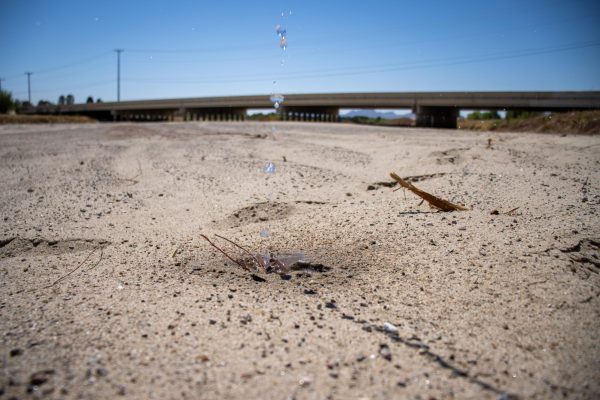In a historic move, the U.S. has denied Mexico’s request for water from the Colorado River–putting renewed pressure on the water treaty between the two nations. As both countries face internal backlash over the treaty’s obligations, border cities like El Paso and Juárez may soon feel the effects trickle down from the federal level.
The Water Treaty signed on Feb. 3, 1944, was the second water distribution treaty between the U.S. and Mexico that addressed the utilization of the surface water from the Rio Grande and Colorado River. In recent news, Mexico has fallen behind on delivering the U.S. their allotment of water.
According to the International Boundary and Water Commission (IBWC), headquartered in El Paso, Texas, the U.S. is supposed to receive nothing less than 350,000 acre-feet annually of water flow from Mexico’s six named measured tributaries within five-year cycles.
As of April 19, over four years into the current cycle, Mexico has delivered 530,508 acre-feet to the U.S., giving Mexico six more months until the full five-year cycle ends in October.
The U.S. is required to transfer 1.5 million acre-feet of Colorado River water to Mexico yearly. According to a post on X made by the Bureau of Western Hemisphere Affairs, the U.S. denied a non-treaty request, a first in 81 years of the treaty, for a special delivery from the Colorado River to Tijuana, which is facing severe drought like much of northwest Mexico.
University of Texas at El Paso (UTEP) professor Dr. Josiah Heyman explains what this request could do for Mexico in regard to the treaty.
“[Mexico’s] request would be taken from their treaty amount and it would be counted under the treaty, but the United States has the discretion to not deliver the water, and they didn’t,” Heyman said.
Texas is a critical state in midst of the water dispute as farmers in South Texas depend on the water deliveries from Mexico.
As an expert in border trade issues and water sustainability, Dr. Heyman, highlights the implications Mexico’s water debt is having in Texas, but that no formal treaty obligations have been broken as of now.
“People in the United States are unsatisfied because there’s significant powerful, wealthy industrial farming interests in South Texas that are not getting as much water as they would like to perform. They are not happy that they’re not getting this annual delivery the treaty promises, but we haven’t gotten to that five point yet,” Heyman said.
River water is relatively easy to control physically as the flow of the river can be measured more precisely to meet the numbers of the treaty, but according to Dr. Alex Mayer, UTEP professor of civil engineering and director for the Center for Environmental Resource Management, the groundwater isn’t so easy to control.
“The groundwater is very imprecise because you can’t see it–we don’t really know how big the aquifers are, they cross the border,” Mayer said. “In other words, either country can pump as much as it wants within the limits of the national or state limitations…In Mexico you have to file a permit and in Texas you can pump as much as you want essentially… Also in Texas, how much people pump is private.”

Being a desert city with rain on rare occasions, El paso depends heavily on the river water, but also the groundwater.
“We use the groundwater at a rate that is much greater than the recharge. That means we are steadily depleting groundwater aquifers,” Mayer said. Dr. Heyman mentions that northern Mexico and the southwestern United States are both extremely vulnerable regions because they’re very dry climates with large cities.
“The bigger picture is not just that Mexico delivers the water, but there’s more demand for water there more mechanism of drought,” Heyman said.
In response to ongoing water scarcity, El Paso Water has worked on many methods of sourcing water such as desalination, wastewater reuse and leasing agricultural water, but these efforts require large amounts of technology and labor.
As reported by El Paso Matters, beginning in March, El Paso households have begun seeing a water bill increase of about $6, an increase of many over the last decade used to help pay for El Paso Water’s many renovations.
Both Dr. Mayer and Dr. Heyman have worked together to examine the impact of the rise in water bills for consumers in El Paso.
“I talk to people all the time about their water bills and electric bills…They feel stressed, they have a hard time doing things that would otherwise be good for them like putting trees in their yards on the south and westside of their yards to cool their homes,” Heyman said.
Despite conservation efforts in cities like El Paso, the pressure of dwindling water sources can be tied to global climate change, economics–and to Heyman, even the structure of the 81-year-old treaty itself.
“Mexico could once again catch up, but the problem is that the agriculture depends on its annual flow. Exactly what the people who made the tribute were thinking in 1944 when they made this five-year mechanism instead of having it a requirement every single year–I don’t know,” Heyman said.
With climate pressures rising and trust in old treaties wavering, the water that flows through two nations can soon test how far their cooperation can go on.
Evelyn Palma is the web and copy editor for The Prospector and may be reached at [email protected] and on Instagram @evelynp.media.








kellykelly • May 2, 2025 at 1:24 PM
🔥🔥🔥🔥